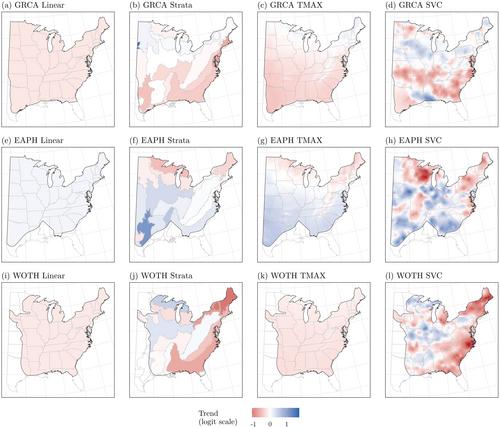Species distribution models (SDMs) are increasingly applied across macroscales using detection-nondetection data. These models typically assume that a single set of regression coefficients can adequately describe species–environment relationships and/or population trends. However, such relationships often show nonlinear and/or spatially varying patterns that arise from complex interactions with abiotic and biotic processes that operate at different scales. Spatially varying coefficient (SVC) models can readily account for variability in the effects of environmental covariates. Yet, their use in ecology is relatively scarce due to gaps in understanding the inferential benefits that SVC models can provide compared to simpler frameworks.
Here we demonstrate the inferential benefits of SVC SDMs, with a particular focus on how this approach can be used to generate and test ecological hypotheses regarding the drivers of spatial variability in population trends and species–environment relationships. We illustrate the inferential benefits of SVC SDMs with simulations and two case studies: one that assesses spatially varying trends of 51 forest bird species in the eastern United States over two decades and a second that evaluates spatial variability in the effects of five decades of land cover change on grasshopper sparrow (Ammodramus savannarum) occurrence across the continental United States.
We found strong support for SVC SDMs compared to simpler alternatives in both empirical case studies. Factors operating at fine spatial scales, accounted for by the SVCs, were the primary divers of spatial variability in forest bird occurrence trends. Additionally, SVCs revealed complex species–habitat relationships with grassland and cropland area for grasshopper sparrow, providing nuanced insights into how future land use change may shape its distribution. These applications display the utility of SVC SDMs to help reveal the environmental factors that drive species distributions across both local and broad scales. We conclude by discussing the potential applications of SVC SDMs in ecology and conservation.



